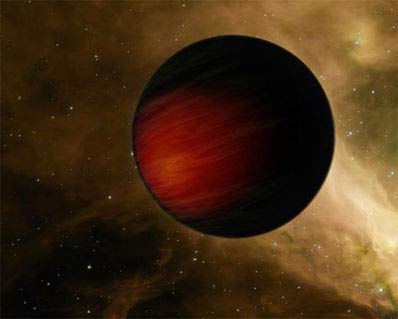Discovering planets hotter than 2,000 degrees Celsius
Scientists on May 9 said they have discovered an outer planet. The solar system is about the same size as Saturn, with temperatures of more than 2,000 degrees Celsius, the hottest planet ever.
This finding is based on images and data provided by the Spitzer telescope of the US Aerospace Agency (NASA). Accordingly, the temperature of this planet - named HD 149026b - is 2,040 degrees Celsius, which is equivalent to the temperature on the surface of giant red stars and is about ½ of the surface temperature of the sun.
"The temperature on this planet is much higher than the temperature of the planets we used to know," Drake Deming, of NASA's Goddard Flight Center in Greenbelt, coauthored the findings.
According to scientists, HD 149026b is a dark planet, meaning that it absorbs most of the light from the stars approaching it.
HD 149026b orbits a star orbit in the constellation Hercules, 279 light-years from Earth. Scientists believe that detecting the different characteristics of planets outside the solar system will help to improve the understanding of planets.

(Photo: NASA)
WALL VY
- The temperature of the oceans billions of years ago is not hotter than today
- Central in the hot 39 degrees Celsius
- Cold air strengthens, the North is at least 2 degrees Celsius
- Temperatures in the Northern provinces are down to 14 degrees Celsius
- Bac Bo was sunk in cold weather, Hanoi 14 degrees Celsius
- New discovery of the heat of Earth's core coating
- The star is 36 times hotter than the sun
- Stunning photos at minus 9 degrees Celsius
- The North received more cold spells, many places below 13 degrees Celsius
- Traffic lights are melted in the heat of 50 degrees Celsius in Mexico
- How will the body change when the temperature drops to 10 degrees Celsius?
- Hot earth 2 degrees Celsius will have worse consequences than heating up only 1.5 degrees Celsius, why?
 Van Allen's belt and evidence that the Apollo 11 mission to the Moon was myth
Van Allen's belt and evidence that the Apollo 11 mission to the Moon was myth The levels of civilization in the universe (Kardashev scale)
The levels of civilization in the universe (Kardashev scale) Today Mars, the sun and the Earth are aligned
Today Mars, the sun and the Earth are aligned The Amazon owner announced a secret plan to build a space base for thousands of people
The Amazon owner announced a secret plan to build a space base for thousands of people